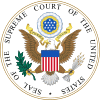| Continental Paper Bag Co. v. Eastern Paper Bag Co. | |
|---|---|
 | |
| Argued April 15, 1908 Decided June 1, 1908 | |
| Full case name | Continental Paper Bag Co. v. Eastern Paper Bag Co. |
| Citations | 210 U.S. 405 (more) 28 S. Ct. 748; 52 L. Ed. 1122; 1908 U.S. LEXIS 1519 |
| Case history | |
| Prior | 150 F. 741 (1st Cir. 1906) |
| Holding | |
| It was not unreasonable for a patent owner to use existing equipment embodying old technology rather than to build new machines using new patents. Also, it was not unreasonable for the patent owner to refuse to license others to use its new patents. | |
| Court membership | |
| |
| Case opinions | |
| Majority | McKenna |
| Dissent | Harlan |
Continental Paper Bag Co. v. Eastern Paper Bag Co., 210 U.S. 405 (1908), was a case in which the Supreme Court of the United States established the principle that patent holders have no obligation to use their patent.[1]
Facts
Eastern Paper Bag brought an action to prevent its competitor Continental Paper Bag from using its patent for a "self-opening" paper bag. Continental Paper Bag alleged that Eastern Paper Bag was not using its patent but simply trying to suppress competition.
Decision of the Supreme Court
The Supreme Court rejected this argument by Continental Paper Bag, holding that it was the essence of the patent to exclude others without question of motive.
See also
- List of United States Supreme Court cases, volume 210
- Hartford-Empire Co. v. United States, 323 U.S. 386 (1945)
Further reading
- Chin, Yee Wah (1997). "Unilateral Technology Suppression: Appropriate Antitrust and Patent Law Remedies" (PDF). Antitrust Law Journal. 66: 441. Archived from the original (PDF) on 2008-07-19.
- Hovenkamp, Herbert; Janis, Mark D.; Lemley, Mark A. (2005). "Unilateral Refusals to License in the U.S". Working Paper No. 303, Stanford Law School John M. Olin Program in Law and Economics. doi:10.2139/ssrn.703161.
External links
 Works related to Continental Paper Bag Company v. Eastern Paper Bag Company at Wikisource
Works related to Continental Paper Bag Company v. Eastern Paper Bag Company at Wikisource- ^ Text of Continental Paper Bag Co. v. Eastern Paper Bag Co., 210 U.S. 405 (1908) is available from: CourtListener Findlaw Google Scholar Justia Library of Congress